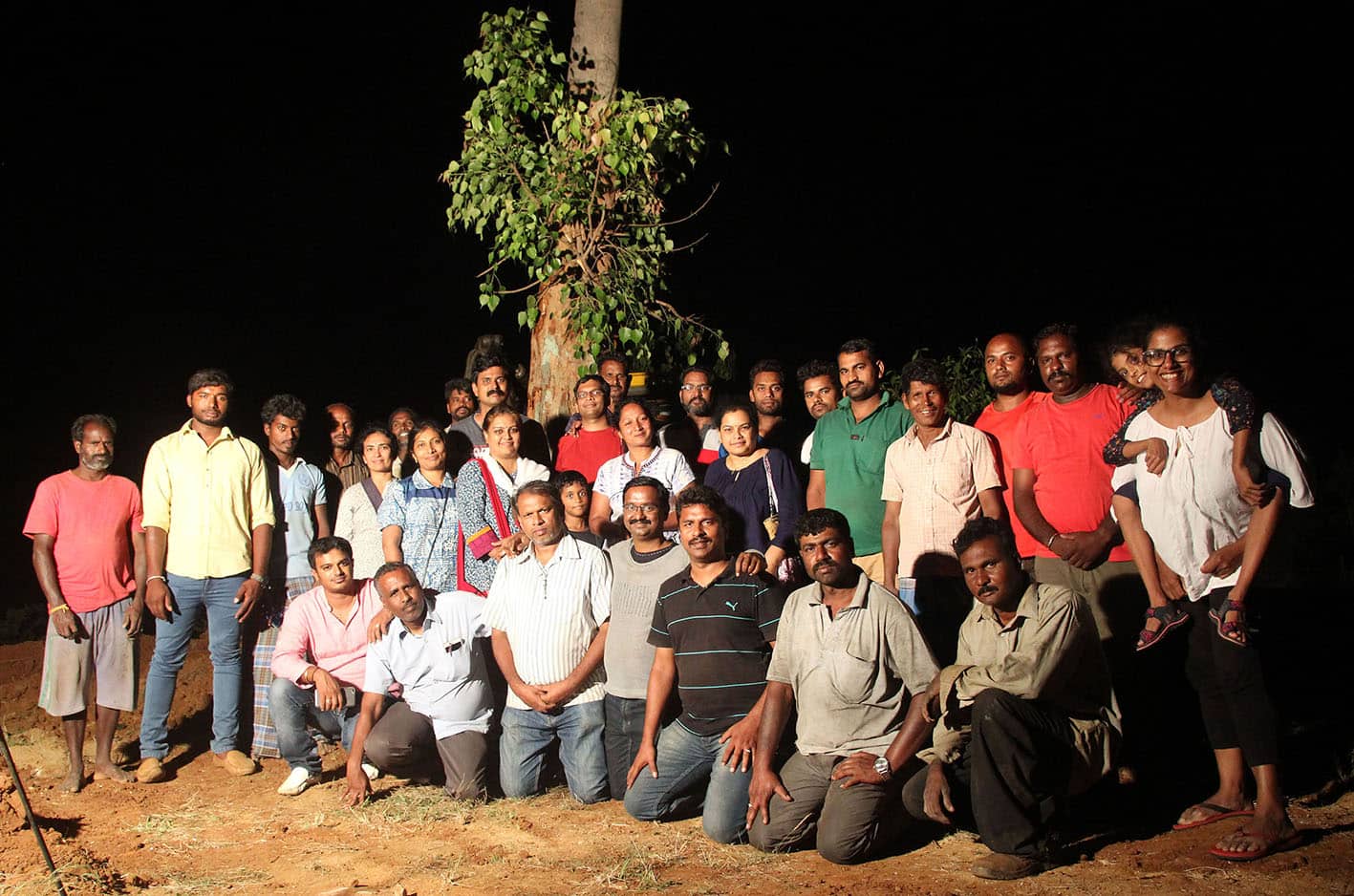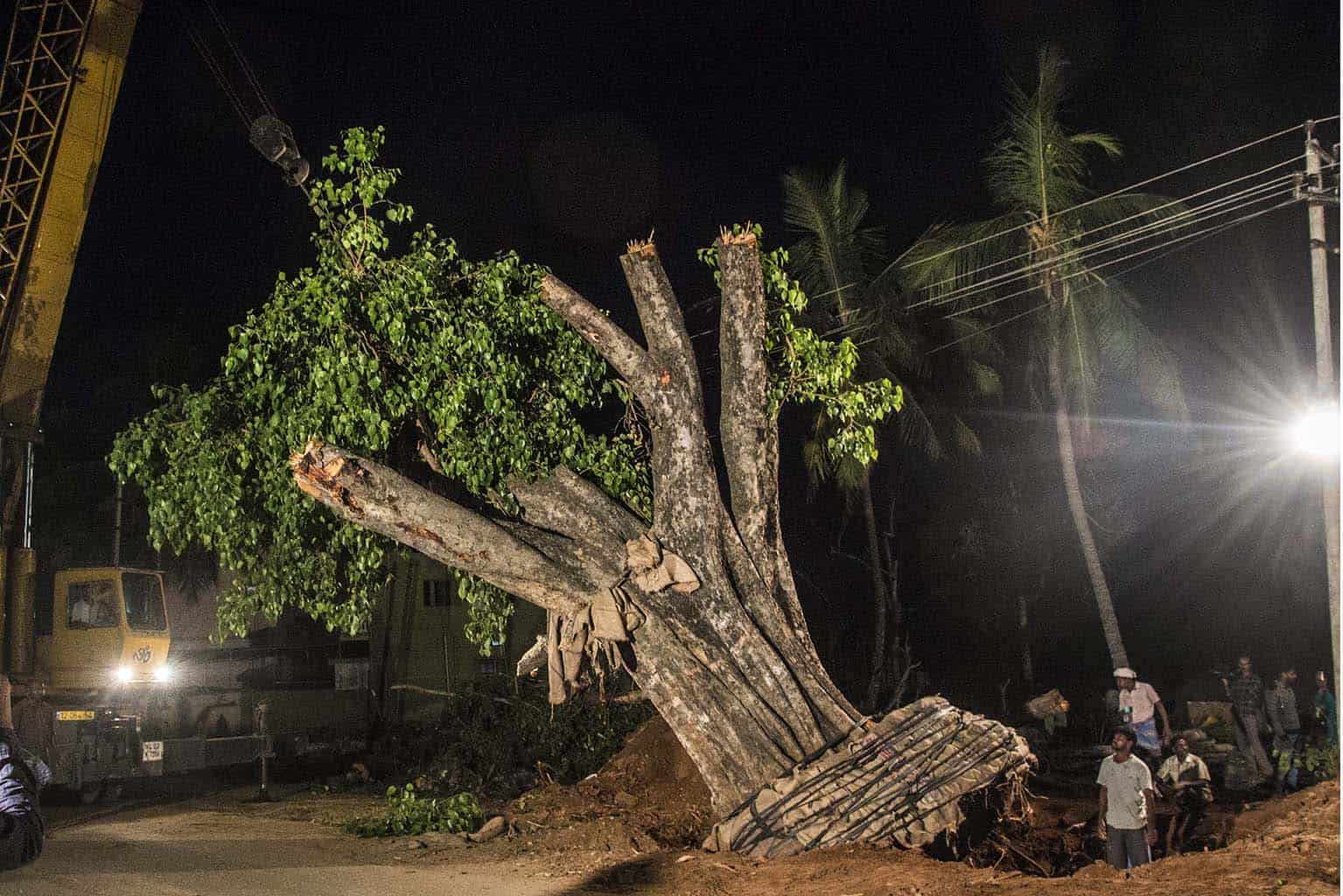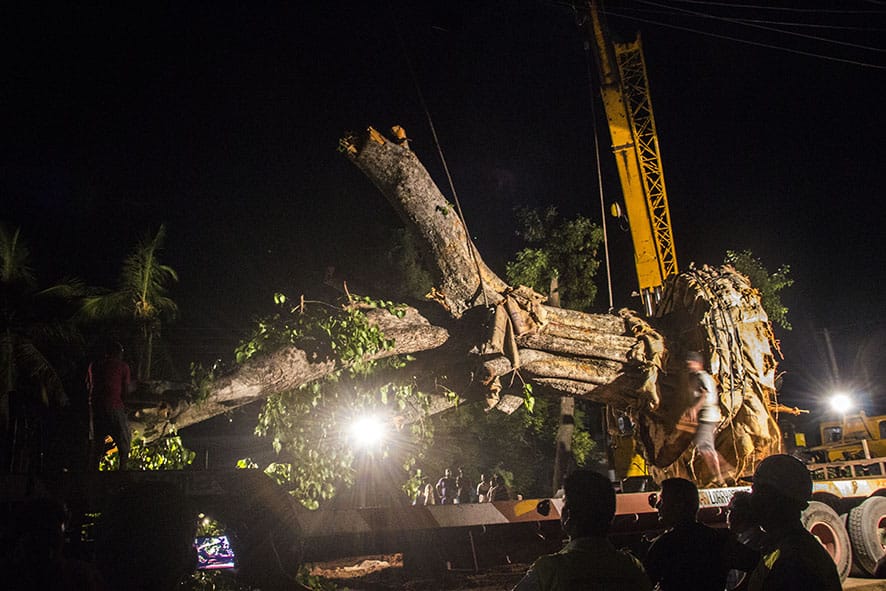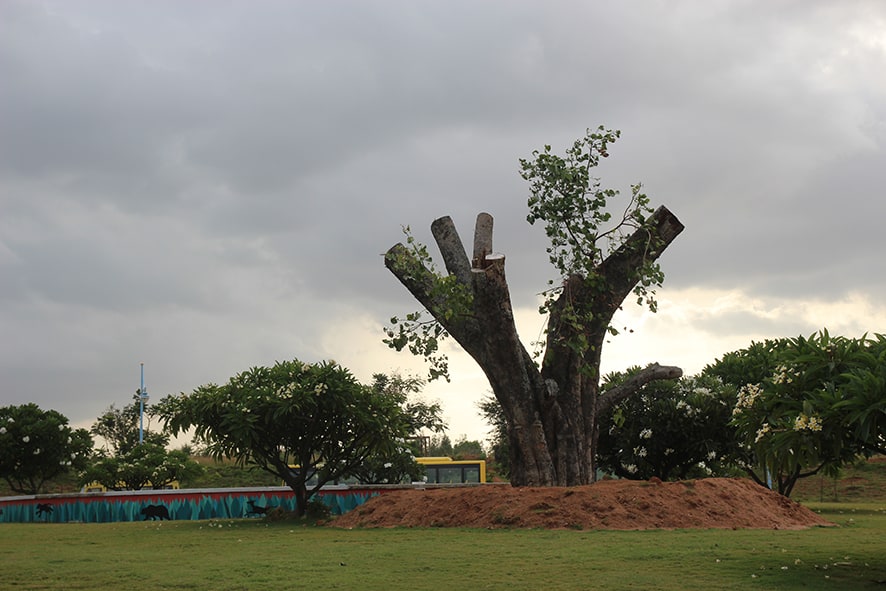In May 2017, members of the Sarjapura Residents Welfare Association (SRWA) initiated a project that turned out to be India’s first crowd-funded tree transplantation exercise.

Tree identified and prepared for transplantation
Since the initial months of 2017, scores of huge old trees – some even centuries old, were being axed to clear space for roads to be widened from Dommasandra to Sarjapura and beyond. Local residents couldn’t protest against this road widening, since getting good roads for their travel was indeed crucial for them. However, they could not bear the pain of losing these grand old trees and total annihilation of the lush green cover around.
That’s when tree transplantation sounded attractive to them. The whole activity was an eye opener for the entire team. Even when things seemed insurmountable at the start, the intention and the spirit of teamwork continuously inspired encouragement, support, timely help and full success.

The learning and suggestions we gathered from the experience have made this guide possible. We hope this will help many groups in Bengaluru and elsewhere, where people are looking to save trees.
Phase 1:
- Identify the trees: Ficus trees, such as peepal, banyan etc, have a greater rate of successful transplant. However, in our experience, the neem tree that we transplanted took about six weeks more to show new leaves, but was one of the trees that caught on well post-transplantation. Remember: The energy you are putting in has a huge contribution towards successful execution and outcome of a transplantation.
- Checking the tree’s current status: Make a document with details of the trees. In their initial locations, what is the girth of each tree, how much space is there between them, how many electricity lines are running near them and any other relevant, practical information. This information will help when the details may be needed during the implementation stage. This document will help in clarity of communication with the tree expert and with the people who operate machinery later on.
- Departments involved: PWD, BESCOM, Forest Office, Police/Traffic Police– who will co-ordinate with which sections – how is the work going to be broken down. Make use of the contacts you or your team members have. Check out the protocol for permissions. An initial visit to share the idea and garner support for the project works well.
- Local support initiation: Sometimes the trees may have small shrines, or other things connected – maybe a makeshift shop etc. Make sure you connect to the people involved – in our experience they were enthusiastic and supportive to the initiative because it was clear to them, that this group had come to save ‘their’ tree. The amount of local support and practical on site support that this generates is indescribable.
- Identify your transplantation expert: The expert who helped SRWA was Jeyam Landscaping, (Mr. Ilangovil Subramaniam) alongwith his team from Chennai. Make sure you have clarity about the scope of work. Post-transplant care phase is a key area to check. Speak to your expert and see how much expertise he has in after care, what support he has to offer in this phase. Also, it is important to find out what type of post-transplant care you as a team want to go for – holistic/ natural/ organic/ chemical inputs – discuss clearly with the tree expert.
- Funding: By now, you should also estimate and strategize fundraising for the transplant. With the distances that we had planned, our costs came to approximately 1 lakh per tree. This will depend on the number and size of the trees, distances between location of the tree and the new location. Transportation and machinery costs are the major chunk of the expense.
- Identify the area of transplantation. Keep in mind:
- The distance is likely to impact the cost. The closer the new spot is to the tree location, the lesser the cost of the trailer, crane, JCB etc would be.
- If there are obstructions in the entry of the transplantation location, ensure enough space for the tree to pass through.
- Good water supply is must. Post-transplantation care is a rigorous job. Water needs to be sprinkled from a height to help the trunk and bark of the tree soak in water.
- The place should be regularly accessible. A small team of volunteers will need to visit regularly.
- If the source of water is a pipe, you will need to buy a long water hose for watering the tree post transplantation.
Phase 2
- Chalk out your plan of action: Once the basics have been worked out, it’s time for actual plan of action. Dates should be fixed. This is important, as government departments have certain stipulations about notices being sent out and number of days advance notice inter-departmentally etc.
- Government permissions: Letters to specific departments to be drafted. When you meet with officials, make sure you speak for the trees, for the environment and for the future generation. These are points that are beyond smaller agendas and every person does understand and connect to these issues. Departments that SRWA liaised with are the local Panchayat, BESCOM, Forest Department – to the DFO, PWD. Especially in the BESCOM – they need clarity of dates about any pole to be shifted – official intimation about power shut down for a certain day/time must be published in the newspaper etc. so a clarity in dates helps them to execute their part better.
- Identify a tree pruner: Before the trees can be transplanted, the big branches will need to be pruned.
- Materials required: Your transplantation advisor would have a list of requirements, such as river sand, gunny bags, cycle tyres etc. Acquiring river sand directly from the market is a good idea. Some vendors might be sympathetic towards the cause the sand will be used for, and may bring their price down a bit.
- Food and accommodation for team of workers must be provided in a place near the site.
- You will better-understand the project after meeting the expert. Contact the JCB, crane and trailer operators. They will give you an estimate of the tonnage of machinery required. This can vary depending on the size and weight of the tree. At this point, you can take the cost estimates from the suppliers.
- Submit a letter to the police department requesting their cooperation. This is important if the transplantation spot is near a road – there will be traffic delays and the police support and coordination will help. Members of your team can also help streamline traffic on the day of transplantation.
- The translocation may need to happen at night, unless the tree is located in a quiet empty spot. If the area is dark during the transplantation, arrange for adequate lighting. The tree needs to be placed as straight as possible, and good light in the area may be crucial.

The on-site preparations must begin three days in advance. This will depend on how many trees would be transplanted, advice of your expert, availability of workers and other factors.
Phase 3
This is the actual process:
- Root balling: JCBs will dig around the base of the tree up to 2-3 feet deep. All around in a certain diameter, and the main roots will be packed with gunny bags and cycle tubes. This is a root ball.
- At the new location, a pit is dug to accommodate this root ball. There are specifications for this, decided by the transplantation expert.
- Branches of the tree are pruned. Insecticide solutions are applied to the exposed/cut areas to avoid fungal infection, termites or bacterial infections. These can all attack a weak tree. A special decoction of orange oil and beeswax prepared by Vijay Nishanth helped us.
- The timing of shifting the tree depends on factors unique to each situation. In our case, even though the above activities were done during daytime, we had to wait late night for the traffic flow to decrease. The trees we transplanted were on the Dommasandra – Sarjapur road, in a village called Yamere.
- The tree will be shifted back and forth by JCB till the roots are loosened in the ground, simultaneously the crane will be holding the trunk. When the tree is loose enough to be lifted, the crane lifts it up and places it on the truck.

- While the crane and JCB are working on small roads, the traffic should be stopped. Plan this ahead. Set up a system of communication between the individual members controlling traffic. When multiple decisions are taken at several points of two-way traffic flow, there can be many miscommunications and avoidable delays.
- Some seemingly small branches could actually be long when placed horizontally. Make sure your pruner is readily available to trim off any branches that need to be shortened.
- When the tree is being carried to the place of transplant, make sure the pruner is handy, when the entryway, arch or other obstructions are restricting the tree from entering, since the tree may need additional pruning.
- The tree will again be lifted by the crane into the pit dug for it. The JCB may have to adjust the angles. The JCB will then fill the sand and soil into the base to firm it up.
- If there are gashes on the tree trunk, caused when the crane lifts the tree, orange oil/beeswax solution needs to be applied to prevent infections.
When the transplantation is complete, the real wait begins. Success of the transplantation depends on the quality of post-transplant care. Make sure you account for this stage and keep money for it.

If transplantation is done just before the rains, it is helpful. Otherwise there needs to be good water supply, and arrangements to sprinkle water from the top. Regular application of nutritional and antibacterial compositions is crucial in promoting growth and avoiding infection. There are many approaches to it.
Panchagavya, Jeevamrutha and other natural methods are used in the holistic approach. Another approach uses antifungal chemicals and growth promoters. These need to be discussed beforehand, and an expert may be able to guide you and address all concerns, to help the team make an informed choice.
Outcome of transplantation in Sarjapur area
Team SRWA transplanted four trees—two banyan trees, one peepal and one neem— approximately 65-years-old. Three of them were adopted by the Inventure Academy in Varthur, and one was taken to the Yamere Lake bed.
10 to 14 days after transplantation, the biggest banyan started growing new leaves. Soon after, the other banyan and the peepal started growing shoots. But neem plant kept us on tenterhooks for 2.5 months. However we did not give up hope. We regularly visited, gathered around it and meditated, and prayed for it, regardless of our religions. We spoke to the tree, cajoled her and expressed our love. When the first four small dark maroon shoots emerged from her dry bark, there was elation in the team.

First shoots that appear after transplantation bring joy and hope with them.
Team SRWA is grateful to all the government officials and individuals who helped us during this process. People from all over the world donated money towards this cause, and we are humbled and grateful.
Our learning: When we do good with an open mind, with a passionate, dedicated team– anything is doable. We ARE the Change.
Awesome article… Very clear ?